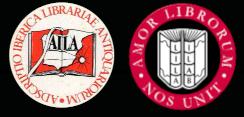


Home |
Temáticas |
Catálogos |
Pedidos |
  |  |
|||||||
|

|
RUGENDAS. (Johann Moritz) HABITANTE DE GOYAS, QUADRO A ÓLEO PINTADO SOBRE MADEIRA. |
|
|
Clique nas imagens para aumentar. LETTRE D’UN ANGLOIS A SON AMI A LA HAYE, [2 OBRAS]Contenant Une Relation Authentique de ce qui s’est passé entre les COURS de LONDRES et de VERSAILLES, au commencement des troubles presents, Tirée des Piéces Originales. A LA HAYE, Chez PIERRE DE HONDT, MDCCLVI [1756]. Tem junto: LETTRE DU DUC DE NEWCASTLE ÉCRITE PAR ORDRE DE SA MAJESTÉ, A MR. MICHELL, Sécretaire d'Ambassade de S. M. Prussienne; en Reponse à L'EXPOSITION DES MOTIFS DU ROI DE PRUSSE, Et au Mémoire, & autres Papiers, remis par le dit Sr. Michell au Duc de Newcastle, Le 23 Novembre, & 13 Decembre 1752. A LA HAYE, Chez PIERRE DE HONDT, M. DCC. LIII. [1753]. 2 Obras encadernadas num volume in 8.º de 20x13 cm. Com iv, 56, 52, [ii] págs. Encadernação da época inteira de pele com nervos, rótulo e ferros a ouro na lombada Ilustrado com uma tabela desdobrável no final da segunda obra com dados precisos sobre as apreensões de navios neutros pelos corsários britânicos e as decisões dos tribunais de Almirantado, questão central nas disputas marítimas anglo-francesas do período. Constitui um documento de valor histórico inestimável. Impressão em caracteres redondos e alguns itálicos sobre papel de qualidade, ornamentada com simples cabeções e florões de remate. Exemplar com leves manchas de humidade e ondulamento das folhas por humidade, mais notável no desdobrável. Apresenta também pequenos picos de traça desde a pasta anterior à folha de rosto da primeira obra, assim como desde a página 41 até à folha de rosto da segunda, sem atingir o texto. Obras muito raras e importantes da literatura diplomática europeia, publicadas no auge das tensões que precederam a Guerra dos Sete Anos (1756-1763). Inserem-se no contexto da chamada «Revolução Diplomática» de 1756, que assistiu ao realinhamento das alianças europeias tradicionais, com a Inglaterra a abandonar a sua aliança secular com a Áustria em favor da Prússia, deixando a Áustria a aliar-se com a França. A primeira obra está presente apenas em algumas das principais bibliotecas europeias, sendo referenciada no catálogo da Biblioteca Nacional de França. A segunda obra, na presente edição de Haia, constitui uma das três edições conhecidas de 1753, estando presente na Biblioteca Nacional da Áustria, mas ausente do catálogo da Biblioteca Nacional de França. As outras duas edições foram publicadas em Londres (Edward Owen, em francês) e Frankfurt am Main (Knoch und Esslinger, edição bilingue francês-alemão). A reunião destas duas obras num único volume, com paginações distintas e folhas de rosto independentes, constitui um testemunho bibliográfico precioso da literatura diplomática que precedeu um dos conflitos mais decisivos da história moderna europeia. A primeira peça, apresentada sob a forma epistolar anónima de um inglês ao seu correspondente em Haia, constitui uma resposta às "Lettres de l'Observateur Hollandais", conforme indicado pelo catálogo da Biblioteca Nacional de França. O Observateur Hollandais era um periódico político editado por Jacob-Nicolas Moreau entre 1755-1759, publicado sob falsa marca tipográfica de Haia mas impresso em Paris, que difundia a perspectiva francesa sobre os acontecimentos europeus através de cartas fictícias. A presente obra constitui, assim, uma sofisticada peça de propaganda diplomática britânica destinada a contrariar a narrativa francesa e justificar a posição de Londres perante a opinião pública europeia. A escolha de Haia como local de publicação não foi casual, uma vez que esta cidade se havia estabelecido como centro de difusão da literatura política europeia, permitindo contornar a censura francesa e assegurar ampla circulação nos circuitos diplomáticos continentais. O texto alega compilar documentos autênticos das negociações diplomáticas entre Londres e Versalhes, procurando refutar as acusações francesas difundidas em memorandos oficiais. A intenção é clara: demonstrar que a França violou sistematicamente os acordos estabelecidos pela Paz de Aix-la-Chapelle (1748), justificando assim a posição beligerante britânica. A segunda obra, datada de 1753, reproduz a correspondência oficial entre o Duque de Newcastle e o secretário da legação prussiana em Londres, constituindo um testemunho direto das complexas negociações que antecederam a reorganização das alianças europeias. O editor Pierre de Hondt estabelecera-se em Haia como um dos principais difusores de obras políticas e diplomáticas do século XVIII, especializado na publicação de documentos oficiais e semi-oficiais. A sua oficina era conhecida pela qualidade tipográfica e pela capacidade de distribuição internacional das obras que produzia. Estas publicações enquadram-se na prática corrente da época de difundir correspondência diplomática através da imprensa, constituindo uma forma primitiva de diplomacia pública destinada a influenciar não apenas os círculos governamentais, mas também a opinião educada europeia. Thomas Pelham-Holles, 1.º Duque de Newcastle (Londres, 1693 – Londres, 1768), serviu como Secretário de Estado durante quase cinco décadas, sendo uma figura central da diplomacia britânica no período. Newcastle havia dirigido entre 1749 e 1753 uma campanha diplomática para conseguir a eleição do filho de Maria Teresa como Rei dos Romanos, procurando formar uma "maioria eminente" de eleitores imperiais. Abraham Louis Michell (Vevey, 1712 – Berlim, 1782) serviu como secretário da embaixada prussiana em Londres durante o período crítico das negociações que antecederam a Guerra dos Sete Anos, sendo o interlocutor direto do governo britânico nas complexas questões diplomáticas relativas às reivindicações prussianas e às tensões crescentes entre as potências europeias. A sua correspondência com Newcastle constitui um testemunho direto das negociações que conduziram ao realinhamento das alianças tradicionais.
2 Works bound in one volume. In octavo. 20x13 cm. iv, 56, 52, [ii] pp. Contemporary full leather binding with raised bands, label and gilt lettering on the spine. Illustrated with a fold-out table at the end of the second work containing precise data on the seizures of neutral ships by British privateers and the decisions of the Admiralty courts, a central issue in Anglo-French maritime disputes of the period. It is a document of inestimable historical value. Printed in round characters and some italics on high-quality paper, decorated with simple headpieces and finishing fleurons. Copy with slight damp stains and curling of the pages due to moisture, most noticeable in the fold-out section. There are also small moth holes from the front board to the title page of the first work, as well as from page 41 to the title page of the second, without affecting the text. Very rare and important works of European diplomatic literature, published at the height of tensions preceding the Seven Years' War (1756-1763). They are part of the context of the so-called 'Diplomatic Revolution' of 1756, which saw the realignment of traditional European alliances, with England abandoning its centuries-old alliance with Austria in favour of Prussia, leaving Austria to ally itself with France. The first work is only available in a few major European libraries and is referenced in the catalogue of the National Library of France. The second work, in this edition from The Hague, is one of three known editions from 1753 and is available in the Austrian National Library, but is not listed in the catalogue of the National Library of France. The other two editions were published in London (Edward Owen, in French) and Frankfurt am Main (Knoch und Esslinger, bilingual French-German edition). The combination of these two works in a single volume, with separate pagination and independent title pages, is a valuable bibliographic testimony to the diplomatic literature that preceded one of the most decisive conflicts in modern European history. The first piece, presented in the form of an anonymous letter from an Englishman to his correspondent in The Hague, is a response to the "Lettres de l'Observateur Hollandais", as indicated by the catalogue of the National Library of France. The Observateur Hollandais was a political periodical edited by Jacob-Nicolas Moreau between 1755 and 1759, published under a false typographical mark in The Hague but printed in Paris, which disseminated the French perspective on European events through fictitious letters. This work is therefore a sophisticated piece of British diplomatic propaganda intended to counter the French narrative and justify London's position to European public opinion. The choice of The Hague as the place of publication was not accidental, as this city had established itself as a centre for the dissemination of European political literature, allowing French censorship to be circumvented and ensuring wide circulation in continental diplomatic circles. The text claims to compile authentic documents from the diplomatic negotiations between London and Versailles, seeking to refute the French accusations disseminated in official memoranda. The intention is clear: to demonstrate that France systematically violated the agreements established by the Peace of Aix-la-Chapelle (1748), thus justifying the British belligerent position. The second work, dated 1753, reproduces the official correspondence between the Duke of Newcastle and the secretary of the Prussian legation in London, providing direct evidence of the complex negotiations that preceded the reorganisation of European alliances. The publisher Pierre de Hondt had established himself in The Hague as one of the leading disseminators of political and diplomatic works of the 18th century, specialising in the publication of official and semi-official documents. His workshop was renowned for the typographical quality and international distribution capacity of the works it produced. These publications were part of the common practice of the time of disseminating diplomatic correspondence through the press, constituting a primitive form of public diplomacy intended to influence not only government circles but also educated European opinion. Thomas Pelham-Holles, 1st Duke of Newcastle (London, 1693 – London, 1768), served as Secretary of State for almost five decades and was a central figure in British diplomacy during that period. Between 1749 and 1753, Newcastle led a diplomatic campaign to secure the election of Maria Theresa's son as King of the Romans, seeking to form an 'eminent majority' of imperial electors. Abraham Louis Michell (Vevey, 1712 – Berlin, 1782) served as secretary of the Prussian embassy in London during the critical period of negotiations leading up to the Seven Years' War, acting as the British government's direct interlocutor in complex diplomatic matters relating to Prussian claims and growing tensions between the European powers. His correspondence with Newcastle provides direct testimony to the negotiations that led to the realignment of traditional alliances. Referências/References: Referência: 2508SB003
Local: M-SACO SB260-06 Caixa de sugestões A sua opinião é importante para nós. Se encontrou um preço incorrecto, um erro ou um problema técnico nesta página, por favor avise-nos. 
|
Pesquisa Simples




|
||
 |
|||
|